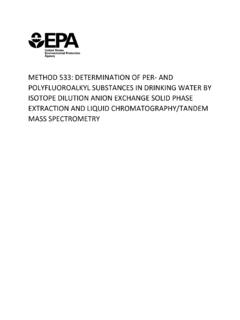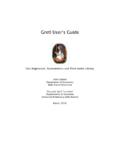Transcription of TSKgel Size Exclusion Chromatography Columns
1 TSKgel Size Exclusion Chromatography Columns Silica-based for protein analysis: Polymethacrylate-based for polar organic-soluble polymers analysis: TSKgel SW mAb TSKgel SW TSKgel Alpha TSKgel SWXL TSKgel SuperAW TSKgel SuperSW. Polystyrene-divinylbenzene-based for Polymer-based for desalting: organic-soluble polymers analysis: TSKgel BioAssist DS Columns TSKgel HXL. TSKgel HHR. Polymethacrylate-based for water-soluble TSKgel SuperH. polymers analysis: TSKgel SuperHZ. TSKgel SuperMultiporeHZ. TSKgel PW TSKgel PWXL. TSKgel PWXL-CP TSKgel SuperMultiporePW For more info visit: 3. Size Exclusion Tips: TSKgel size Exclusion Columns are offered in glass, PEEK (polyetheretherketone), and stainless steel (SS) hardware. SS or Pyrex frits are embedded in the body of the column end-fittings of metal and glass Columns , respectively. The nominal frit size for SS Columns is engraved in the end-fittings; Pyrex frits in the glass Columns have a 10 m nominal pore size.
2 Halide salts corrode stainless steel tubing, fitting, and frits. Do not store SS Columns in a mobile phase containing NaCl and, where possible, use another salt in the operating buffer. Chlorotrifluorethylene and tetrafluorethylene are the materials in the glass column fittings that come into contact with the mobile phase and sample. Good laboratory procedures demand that the analytical column be protected by a guard column. Packed guard Columns are available for use with TSKgel size Exclusion Columns . It is important to employ an HPLC system that is optimized with regards to extra-column band broadening to take full advantage of the high column efficiency that can be obtained on TSKgel SuperSW, SuperH and SuperHZ. Columns . Components such as connecting tubing, injector, injection volume, detector cell volume, and detector time constant may require optimization. TSKgel size Exclusion Columns are supplied with an Inspection Data Sheet, which includes a QC chromatogram and test data, and an OCS Sheet summarizing the recommended operating conditions for optimum column performance.
3 A separate TSKgel Column Instruction Manual that reviews general guidelines for column installation and care, as well as troubleshooting tips for commonly encountered problems, can be downloaded from the Tosoh Bioscience LLC website ( ). Call customer service: 866-527-3587, 4 technical service: 800-366-4875. TSKgel Size Exclusion Chromatography Columns About: Size Exclusion Chromatography Figure 1: Size Exclusion Chromatography Size Exclusion Chromatography (SEC) is the dominant mode of separation for polymers. SEC is the general name for the chromatographic mode in which components of a mixture are separated according to their molecular size, based on the flow of the sample through a column packed with porous particles. Large sample molecules cannot or can only partially penetrate the pores, whereas smaller molecules can access all or a larger number of pores (as demonstrated in Figure 1). In SEC, large molecules elute from the column first followed by smaller molecules, and the smallest molecules that can access all the pores elute last from the column.
4 Size Exclusion Chromatography is the only mode of Chromatography that does not involve interaction with a stationary phase by means of adsorption or partitioning of the solutes. The terms SEC, GFC (gel filtration Chromatography ) and GPC (gel permeation Chromatography ) all refer to the same chromatographic technique. In GFC, an aqueous mobile phase is used, while an organic mobile phase is employed in GPC. The general term SEC covers both uses. TSKgel Gel Filtration Chromatography Columns : GFC. The principal feature of GFC is its gentle non-interaction with the sample, enabling high retention of biomolecular enzymatic activity while separating multimers that are not easily distinguished by other chromatographic methods. SEC has limited peak capacity, however, requiring that the molar mass of the biomolecules differ by at least two- fold. GFC is popular among biochemists for the isolation of protein fractions or for the removal of aggregates in a final polishing step in biotechnology production.
5 GFC. is also frequently used for desalting a (protein) sample solution, often to prepare the sample for elution by another chromatographic mode. SKgel Columns for GFC analysis consist of the T. TSKgel SW and PW series column lines. The main criterion in choosing between these TSKgel Columns is the molar mass of the sample and its solubility. The fact that the TSKgel SW Columns are based on silica and the TSKgel PW Columns are derived from a hydrophilic polymer network has less impact on the separation than the particle and pore size differences between the column lines. Due to higher resolving power, the TSKgel SW series Columns are suitable for the separation of the monodisperse biopolymers such as proteins and nucleic acids. The TSKgel SW mAb Columns within the TSKgel SW series are designed specifically for the analysis of monoclonal antibodies. TSKgel PW series Columns are commonly used for the separation of synthetic water- soluble polymers because they exhibit a much larger separation range, better linearity of calibration curves, and less adsorption than the TSKgel SW Columns .
6 While a TSKgel SW column is typically the first column to try for biopolymers, TSKgel PW Columns have demonstrated good results for smaller peptides (<1,000. Da), protein aggregates, DNA fragments, and viruses. For more info visit: 5. TSKgel Gel Permeation Chromatography Columns : GPC Table 1: All TSKgel SEC Columns share these features and benefits Features Benefits GPC plays an important role in the characterization of polar organic-soluble and organic-soluble polymers in consumer, Minimal swelling and excellent chemical, and petrochemical industries. GPC is often used Rigid hydrophilic and physical strength; Low to determine the relative molar mass of polymer samples as hydrophobic packings adsorption resulting in high well as the distribution of molar masses. mass recovery Four series of SEC. TSKgel Alpha and SuperAW Columns were developed Suitable for both types of size Columns with different for the GPC analysis of polymers of intermediate Exclusion , aqueous (GFC) and ranges of solvent polarity.
7 The TSKgel Alpha Columns are compatible non-aqueous (GPC). compatibility with a wide range of solvents. TSKgel SuperAW. Columns are based on the same chemistry as TSKgel analytical and preparative Easy scale up Alpha Columns but have smaller particle sizes and pre-packed SEC Columns shorter, narrower column dimensions for high throughput applications. For the GPC analysis of organic-soluble polymers, Tosoh developed TSKgel H series Columns . Each line of Columns within the TSKgel H series differs in degree of inertness and operating temperature range. Call customer service: 866-527-3587, 6 technical service: 800-366-4875. TSKgel Size Exclusion Chromatography Columns About: TSKgel SW Series Size Exclusion Columns Recommendations for TSKgel SW series selection: Tosoh recently added three TSKgel SW mAb Columns to Samples of known molar mass the renowned line of TSKgel SW series SEC Columns . The TSKgel SW mAb Columns meet the growing demand for - Calibration curves for each TSKgel SW series column the higher resolution and high throughput separation of are provided in this HPLC Column Product Guide.
8 Each monoclonal antibody (mAb) monomer and dimer/fragment, curve represents a series of various standards (protein, as well as higher resolution of mAb aggregates. While mAb PEO, or globular proteins, for example) with known can be analyzed using many different modes of HPLC, size molar masses. The molar mass range of the compound Exclusion is best for aggregation, dimer, and fragmentation, to be analyzed should be within the linear range of making it the best method for heterogeneity studies. the calibration curve and similar to the chemical composition and architecture of the standards used to TSKgel SW series SEC Columns contain a large pore volume construct the calibration curve. per unit column volume. This is critical in SEC, because the more pore volume per unit column volume, the better Samples of unknown molar mass two proteins of different molar mass are separated. TSKgel SW mAb, SW, SWXL and SuperSW Columns are based on - Use the TSKgel QC-PAK GFC300 column to develop the highly porous silica particles, the surface of which has been method (scouting) and the TSKgel G3000 SWXL column shielded from interacting with proteins by derivatization to obtain the highest resolution.
9 With ligands containing diol functional groups. TSKgel SW. series Columns stand out from other silica- or polymer- - If the protein of interest elutes near the Exclusion based high performance size Exclusion Columns by virtue of volume, then a TSKgel G4000 SWXL column is the their large pore volumes and low residual adsorption. logical next step. Conversely, if the protein of interest elutes near the end of the chromatogram, try a TSKgel TSKgel SW mAb, SW, SWXL and SuperSW Columns are G2000 SWXL column. stable from pH to and can be used in 100% aqueous conditions. The different pore sizes of the TSKgel SW series Proteins (general). Columns result in different Exclusion limits for globular proteins, polyethylene oxides and dextrans, as summarized - Choose one of the TSKgel SWXL Columns using the in Table 2. Furthermore, different particle sizes, column calibration curves to select the appropriate pore size dimensions and housing materials are available for each of based on knowledge or estimate of protein molar the TSKgel SW series Columns .
10 Mass. The column internal diameter of TSKgel SuperSW Columns Monoclonal antibodies has been reduced from mm ID to mm ID to provide higher sensitivity in sample-limited cases and to cut - TSKgel SW mAb Columns are ideal for the analysis down on solvent use. It is important to employ an HPLC of monoclonal antibodies. Alternatives include system that is optimized with regards to extra-column the TSKgel G3000 SWXL and TSKgel SuperSW3000. band broadening to take full advantage of the high column Columns when sample is limited or the components of efficiency that can be obtained on these Columns . interest are present at very low concentrations. TSKgel BioAssist Columns are available within the TSKgel Peptides SWXL line. These Columns are made of PEEK housing material to reduce sample adsorption to stainless steel or - TSKgel G2000 SWXL Columns are the first selection for glass. Also available within the TSKgel G2000 SWXL and the analysis of peptides.

